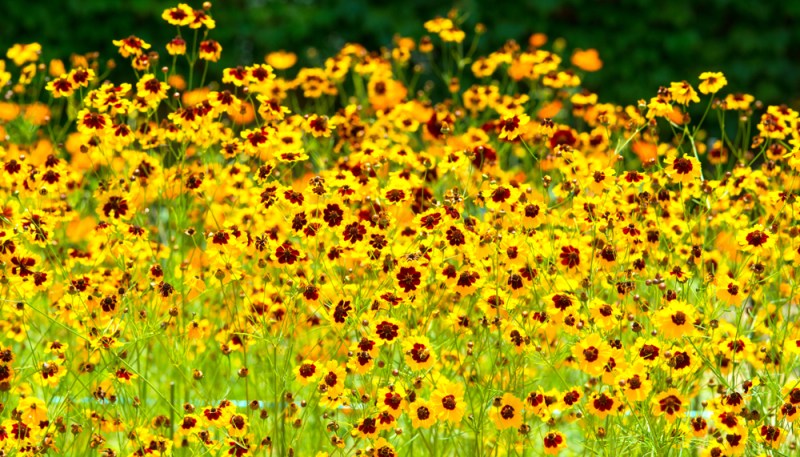How To Identify A Coreopsis Plant
Here’s to a beautiful plant with an extremely unattractive name. The origin of tickseed’s scientific name, coreopsis perennial, comes from combination of two Greek words: “koris,” meaning bedbug, and “opsis,” meaning view. Growing natively throughout the Americas are varieties in bright and pale yellow, white, red, and all sorts of combinations thereof. Most are characterized by attractively toothed petals. Let’s learn more about this prairie and woodland beauty.
Plant Profile:
- Botanical Name: Coreopsis
- Common Name: Tickseed, Pot of Gold
- Plant Type: Perennial flower
- Mature Size: 10 to 18 inches tall and 12 to 24 inches wide
- Bloom Time: Summer
- Flower Color: Yellow, orange, pink, red
- Hardiness Zones: 4-9, USDANative
- Area: Prairie and woodlands of North America
6 Varieties of Coreopsis Plants
1. Coreopsis Verticillata or Moonbeam Coreopsis

Shutterstock/Jay Berkman
Perhaps the most popular perennial tickseed is the moonbeam coreopsis. It has thread-like leaves, and is one of the tallest coreopsis. It can reach anywhere between 18 to 36 inches high, and needs 2 to 3 feet to spread. It provides yellow summer flowers.
2. Coreopsis Tinctoria or Golden Tickseed or Plains Coreopsis

Shutterstock/Dave Hansche
The another common annual species that you’ll find, is the golden tickseed or plains coreopsis, native as its name indicates to the plains of the Central U.S. It has spread throughout many western and southern states where it can be found in disturbed areas, such as ditches along roadsides.
3. Coreopsis Auriculata or Mouse-Ear Coreopsis

Shutterstock/lamart 1971
The mouse-ear coreopsis gets its great name from the two sections of the leaves that stick out like mouse ears. The yellow spring flowers appear above the dark, evergreen foliage. As with the annual coreopsis, this and most the perennials reach 1 to 2 feet tall.
4. Coreopsis Grandiflora or Large-Flowered Coreopsis

Shutterstock/Traveller70
Another popular perennial coreopsis is the large-flowered coreopsis (that’s what the species name grandiflora means), with quite a few popular selections. It begins flowering in early summer and, with deadheading, should produce more orange to yellow flowers throughout the summer. It, too, is native to southern states, can reach 1 to 2 feet tall.
5. Coreopsis Lanceolata or Lanceleaf Coreopsis

Shutterstock/Iva Fischer
The perennial lanceleaf coreopsis is another southern native, but also is found through the Midwest and is naturalized throughout northeastern states. It is, in many respects, similar to its large-flowered relative, and may hybridize with it. This one, though, may be longer lived and has most of its leaves at the base of plants.
6. Coreopsis Rosea or Pink Coreopsis

Shutterstock/Tatyana Mi
The pink coreopsis species is native from Nova Scotia to Maryland, so performs best in zones 4 to 7. Some of its selections or hybrids may not be quite so winter tolerable. What you find for sale is under one foot high, the rose-pink summer flowers having yellow centers. It has fine, thread-like leaves.
How To Grow Coreopsis Perennials
To keep tickseed flowering, you must deadhead, or cut away spent blooms. But that’s about all the attention you need to pay to these hardy beauties.
Sun And Soil
While this attractive bloomer most definitely has a preference for full sun, it is considerably less particular about soil type. It will grow in acidic, slightly alkaline, sandy, or loamy soil, or even clay.
Fertilizer
Fertilization of growing coreopsis is not necessary. Actually, too much fertilizer may inhibit flower production. All you should need to do is add a little compost in the spring.
Water
Coreopsis will need regular water when first planted until they are established. After that, they are drought tolerant. Water the plants deeply at least once a week to help new roots grow down deeply. Soil should be damp at about 1 inch below the soil surface. Early morning watering is best, so the leaves have a chance to dry during the day.
How to Care For Coreopsis Perennials
Propagation
Although they are rugged plants, they don’t tend to live more than 3 to 5 years. A decrease in flowering is a signal it is time to divide the plants or plant some new ones from seed. For perennial coreopsis, if they begin looking weak with fewer flowers after three years or so, divide them if needed in spring or early fall.
Common Diseases And Pests
For the most part, coreopsis plants grow problem free. Aster yellows is one such problem. Caused by bacteria spread by leafhoppers, aster yellows phytoplasma cause plants to be stunted and turn yellow. Coreopsis flowers may develop green or elongated petals. In damp seasons they many fall prey to snails and slugs and fungal diseases can affect them. To avoid these problems as much as possible, give them plenty of air circulation and plant them in full sun.
